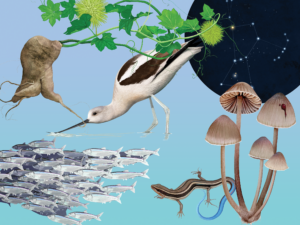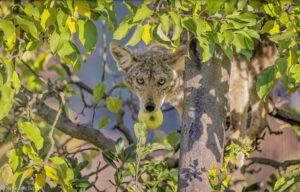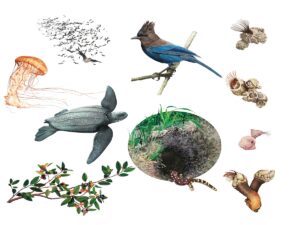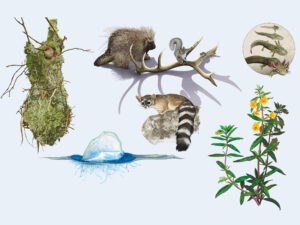
Text and research by the California Center for Natural History
Hunting and nesting
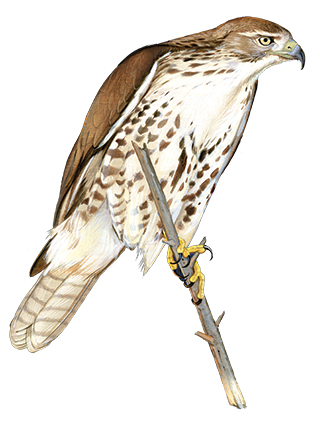
After the fall migration, red-tailed hawks (Buteo jamaicensis) in the Bay Area settle into hunting and wait for rain to trigger a boom in prey, or they prepare to nest, or often they do both. By late February, a pair of red-tailed adults stakes out nesting territory, often in a tall, loose-canopied tree. Sticking close to their nest tree, they may begin incubating eggs as early as March. Hence it’s the juveniles you’re most likely to see in winter. Not old enough to breed, the juvies spend their first solo winter attempting to feed themselves. They soar over open areas in search of food or rest on a perch, sometimes worn down by their hit-or-miss hunting skills. Check fence posts, telephone poles, or snags near grasslands along State Route 1 or over the rolling hills of Marin and Sonoma counties.
Fetid flowers
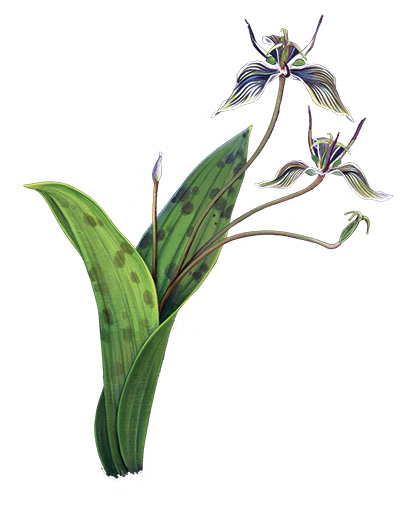
In the shaded, moist understory of coastal redwood forests grow the somewhat stinky, diminutive lily flowers of the fetid adder’s tongue (Scoliopus bigelovii). Found only in California, the species blooms during winter, and in the ’80s scientists wondered who pollinated the flowers at a time when many insects are dormant. It turns out that when it’s cool and wet, two genera of fungus gnats seek out the flowers’ nectar. An individual gnat is so small it isn’t effective at bumping into the right flower parts to achieve pollination, but what the gnats lack in size they make up for in volume. One creature’s fetid scent is another’s lunch.
Super blood moon

A two-in-one lunar event on January 20! At exactly 9:12 p.m. in the Bay Area a supermoon—a moon seemingly larger and brighter than normal due to its fullness and close proximity to Earth—will pass into a total lunar eclipse. Our planet’s shadow will slowly engulf the moon, and then, when it’s fully eclipsed, the supermoon will take on a red hue. The striking color comes from the sun’s long, red wavelengths of light that indirectly reach the moon.
Winter tides
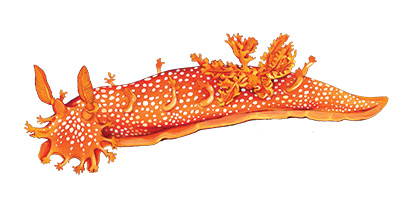
Bay Area high and low tides are at their extremes around winter and summer solstices and during full and new moons. It’s no coincidence that the season’s highest and lowest tides correspond with the lunar eclipse in January. Winter’s low tides around sunset make for excellent tide-pooling and a look at spotted triopha (Triopha maculata), a nudibranch (aka sea slug) whose brilliant colors warn predators of its foul taste. During low tide, nudibranchs wedge into wet rocky crevices or hide under moist seaweed.
Rain lovers
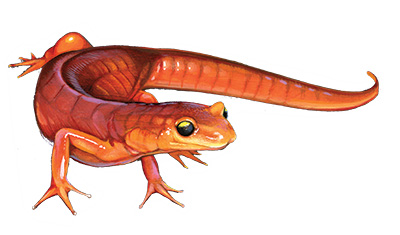
Seasonal rains bring yellow-eyed ensatinas (Ensatina eschscholtzii xanthoptica)—a charming, terrestrial salamander found only in California—out from estivation, a sort of summertime hibernation, to enjoy the wet. Active at night, they take cover under vegetation during the day. Other amphibians also emerge with the rain, and as they traverse roads, cars pose a major danger. South Park Drive in Berkeley’s Tilden Park closes through winter, for example, to protect pond-seeking California newts.
Colony life

Northern elephant seals (Mirounga angustirostris) spend most of the year at sea, migrating great distances to feed. But come late fall through winter they pull their hulking frames ashore onto beaches for the raucous mating and birthing season. Three-foot-long silky black pups are born; harems of females doze in piles; young males watch and wait for their chance, while mature bulls—weighing up to 5,000 pounds—bump chests, bite, and bellow, sparring for the opportunity to mate. Find rookeries in Año Nuevo State Park and Point Reyes National Seashore.

